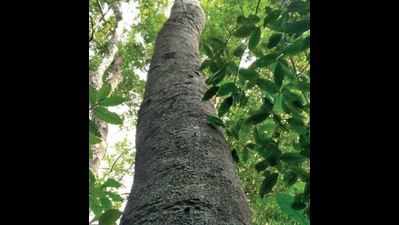- News
- City News
- bengaluru News
- Study seeks conservation reserve tag for swamp forest in Shivamogga
Trending
This story is from August 18, 2019
Study seeks conservation reserve tag for swamp forest in Shivamogga

More than 300 species of angiosperms have been recorded in the swamp near Hulkod village in Shivamogga.
BENGALURU: It was in 2017 that the members of Vruksha Laksha Andolana, a non-profit organisation working in environment sector, stumbled upon a pristine swamp area near Hulkod village of Sagar taluk. They were on a research tour close to the backwaters of Linganamakki reservoir in Shivamogga district.
The swamp is located on a hillock at a height of 300feet.Swamp forests, also known as flooded forests, are green patches inundated with fresh water, either seasonally or permanently.
With the help of Sagar forest division staff and under the guidance of conservation biologist Keshava H Korse, the team conducted a research in the region for two years. The 10-acre swamp is home to Syzygium travancoricum (neeru nerale in Kannada), a rare plant, which was once considered to be on the verge of extinction.
“The flora is unique to fresh water swamps and the endemic species can be found only in a few places of Kerala. The swamp holds water even in summer, thanks to the species composition there. In a way, it also feeds Linganamakki reservoir in addition to fulfilling the drinking water requirements of nearby villages,” said Korse.
“We’ve recommended that Hulkod forest be declared as Rameshwara swamp forest conservation reserve area so that it can be protected by implementing effective participatory conservation practices. Local farmers and the village forest committee can be involved in this. It would be a significant step in protecting this unique habitat of
More than 300 species of angiosperms have been recorded in the swamp. Of them, over 25 species belong to the International Union for Conservation of Nature (IUCN) Red category. Nearly 60 medicinal plant species and 15 riparian tree species were also found. Over 18 mammals, including panther, bison, wild boar, porcupine, squirrels, deer and monkey, are inhabiting it.
“Rare species in the swamp and the speciality of the region are interconnected. Any threat to swamp means death of species and vice-versa,” Korse added.
The swamp is located on a hillock at a height of 300feet.Swamp forests, also known as flooded forests, are green patches inundated with fresh water, either seasonally or permanently.
With the help of Sagar forest division staff and under the guidance of conservation biologist Keshava H Korse, the team conducted a research in the region for two years. The 10-acre swamp is home to Syzygium travancoricum (neeru nerale in Kannada), a rare plant, which was once considered to be on the verge of extinction.
“The flora is unique to fresh water swamps and the endemic species can be found only in a few places of Kerala. The swamp holds water even in summer, thanks to the species composition there. In a way, it also feeds Linganamakki reservoir in addition to fulfilling the drinking water requirements of nearby villages,” said Korse.
Anant Hegde Ashisar, chairman, Vriksha Laksha Andolana, recently submitted a report, ‘Studies on ecological & taxonomical significance of Hulkod swamp forests’ to principal chief conservator of forests (head of forest force) Punati Shridhar.
“We’ve recommended that Hulkod forest be declared as Rameshwara swamp forest conservation reserve area so that it can be protected by implementing effective participatory conservation practices. Local farmers and the village forest committee can be involved in this. It would be a significant step in protecting this unique habitat of
Western Ghats,” he added.
More than 300 species of angiosperms have been recorded in the swamp. Of them, over 25 species belong to the International Union for Conservation of Nature (IUCN) Red category. Nearly 60 medicinal plant species and 15 riparian tree species were also found. Over 18 mammals, including panther, bison, wild boar, porcupine, squirrels, deer and monkey, are inhabiting it.
“Rare species in the swamp and the speciality of the region are interconnected. Any threat to swamp means death of species and vice-versa,” Korse added.
End of Article
FOLLOW US ON SOCIAL MEDIA










